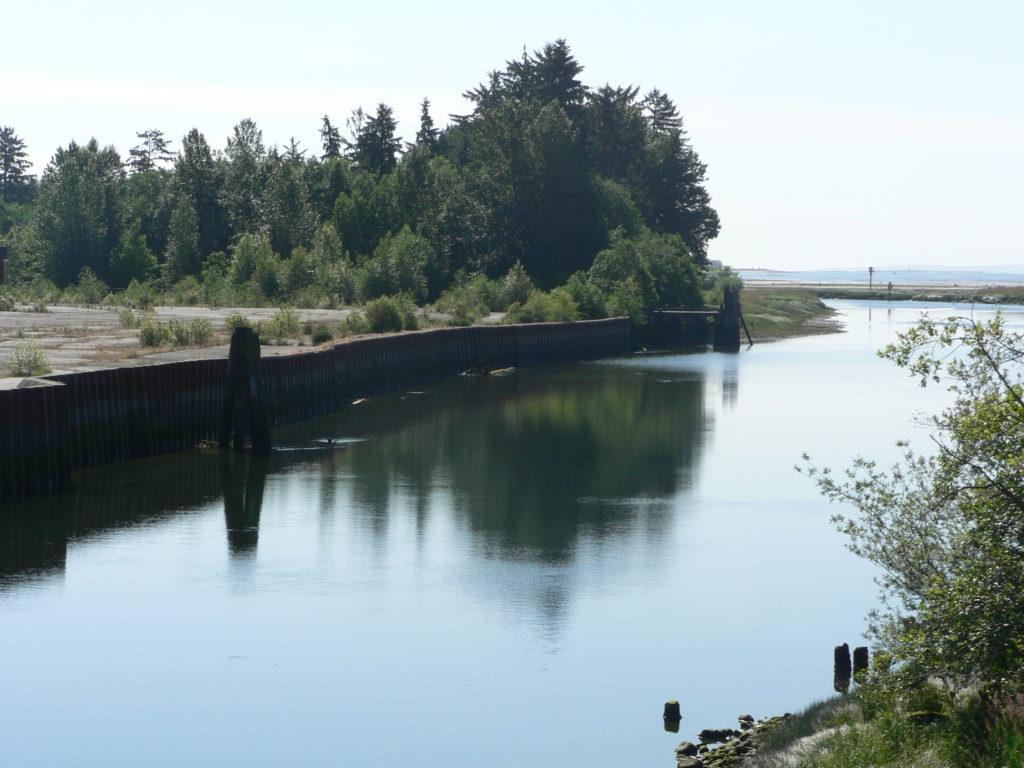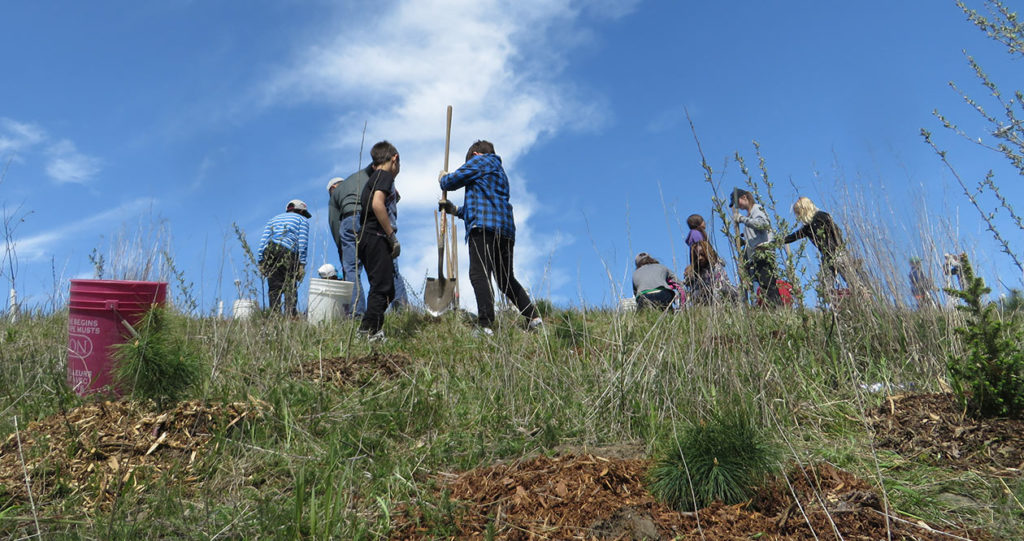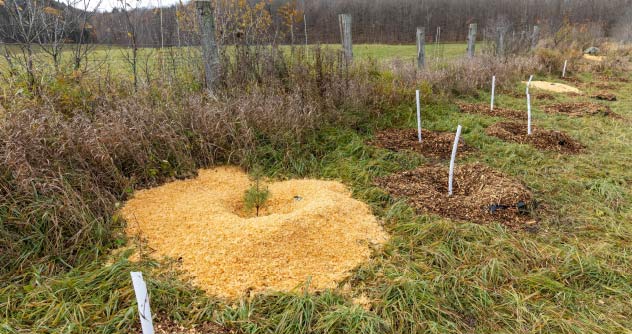Meet 6 groups restoring biodiversity (and storing carbon) across the country
The K’ómoks Estuary should be a sort of salmon superhighway. On the east coast of Vancouver Island, where the Courtenay River meets the Georgia Strait, it is ideally situated to offer passage for both sprightly young salmon migrating to the ocean and their more mature counterparts returning upriver to spawn.
For decades, a sawmill on the river’s northeast bank has restricted that vital traffic.

A 400-metre steel-clad concrete retaining wall built to protect the industrial site also narrowed the channel, creating a bottleneck that gave hungry seals access to a quick and easy meal. The sawmill closed in 2004, and while much of its infrastructure is gone, its adverse effect on the habitat lingers.
But that’s changing thanks to the restoration work of Kus-kus-sum, a partnership between the Comox Valley Project Watershed Society, K’ómoks First Nation and the City of Courtenay. After raising funds to purchase the land, the coalition excavated, crushed and removed tonnes of asphalt, concrete and rebar. Now they’ve begun restoring 3.35 hectares of tidal marsh and riverside forest as well as connecting the site’s revitalized habitat to the adjacent Hollyhock Flats, a conservation area rich in rare plants, fish, and wildlife.
Kus-kus-sum will not only guard against climate change (the restored site will offer better carbon sequestration and flood mitigation) but also increase natural biodiversity; the salmon are getting their superhighway back.
In 2021, Kus-kus-sum was one of seven inaugural grantees in WWF-Canada’s Nature and Climate Grant Program (NCGP). This multi-year initiative, backed by a more than $2-million investment from presenting partner Aviva Canada, funds local and Indigenous-led efforts to combat biodiversity loss and climate breakdown.
Six grantees have just been named in the second round of funding, with projects that will extend into early 2024. Kus-kus-sum is one of three projects to return.
Nature-based solutions are at the heart of all the grantees’ work as they repair and protect local ecosystems which helps drive the ambitious goals of Regenerate Canada, WWF-Canada’s 10-year to recover at-risk species and slow climate change, using nature.
The new grantees: Restoring decades of damage
Three new NCGP grantees started their 2022 field season by taking aim at big problems with a mix of innovative and traditional tactics.
In the fertile heartland surrounding Sussex, NB, decades of intensive agriculture has degraded stream banks and reduced natural floodplain forest cover along local waterways. The Carbon Capture Collective project has a plan to restore it.
Facilitated by Kennebecasis Watershed Restoration Committee, in partnership with the Hammond River Angling Association (HRAA) and Belleisle Watershed Coalition, the participants are measuring the carbon in riverbank soils along the Kennebecasis River, Hammond River, and Belleisle Bay and planting diverse tree species. In two years, they intend to boost biodiversity — the area is home to many at-risk species, including the shortnose sturgeon, Outer Bay of Fundy Atlantic salmon and the butternut tree — while increasing carbon sequestration and restoring a more effective floodplain.
(Fun fact: The HRAA was itself a year-one NCGP grantee, planting nearly 1,500 quick-regenerating, species-supporting, erosion-mitigating shrubs on the banks of Palmer Brook in southern New Brunswick in 2021.)
Over on the west coast of Vancouver Island, 50-odd kilometres up the coast from Tofino, local rivers, lakes and mountainsides still bear the scars of a long-shuttered logging operation that stripped the landscape of timber.
Without the trees that stood proudly for centuries, the habitat has continually degraded, as have local wildlife populations. And landslides, increasingly common due to climate-fueled extreme weather events, make it difficult for new growth to take hold.
Here, the Clayoquot Climate Resilience and Watershed Restoration Project — led by round two grantee Redd Fish Restoration Society in partnership with the ƛaʔuukʷiʔatḥ (Tla-o-qui-aht) and hiškʷiiʔatḥ (Hesquiaht) Nations — has developed an intensive restoration plan. It involves the targeted planting of coniferous trees, willow stakes and native shrubs to stabilize the soil, improve the habitat and accelerate carbon sequestration in two key watershed areas.

And along the banks of Rouge River, which snakes through the eastern edge of Toronto, the Friends of the Rouge Watershed project, another new NCGP grantee, will mobilize 4,000 youth and other volunteers to plant 20,000 native trees and 8,000 native wildflowers and shrubs. This will reduce invasive species and flood risks while returning municipal parkland to healthy habitat.
Their two-year plan will restore six hectares of river-adjacent forest wetlands, hilly forest habitat and wildflower meadows, creating a more biodiverse and climate-resilient pocket amid Canada’s largest urban centre.
Returning grantees: Building on momentum
The three returning grantees — Kus-kus-sum, as well as ALUS Canada and Nottawasaga Valley Conservation Authority (NVCA) — end up with a three-year runway to conduct their important work, laying a foundation for long-term change.

ALUS is a charity that brings together farmers and community members to lead restoration and conservation efforts in sensitive agricultural ecosystems. After restoring more than 26 hectares of habitat in the 2021 field season, in round two ALUS is able to achieve even more thanks to NGCP’s increased multi-year investment. Participants plan to integrate 60 hectares of native grasslands, trees and wetlands in vulnerable farmlands in the Ontario counties of Norfolk, Elgin and Lambton as well as the Quebecois regions of Montérégie and Outaouais. This work is expected to sequester a significant amount of carbon within five years while restoring habitats for several species‐at‐risk, including the Eastern meadowlark, Blanding’s turtle and Monarch butterfly.
Meanwhile, the NVCA is continuing to reduce the strain that agriculture and development have placed on a major watershed system north of Toronto by cultivating “spongier” landscapes: that is, habitats capable of sequestering more carbon and mitigating floods.
The NVCA had a productive first year in the NCGP, planting trees and seeding grasslands with the capacity to store more than 4,200 tons of carbon by 2050. The new two-year campaign will restore more than 99 hectares of wetlands, rivers, forests, and native grasslands by reintroducing native plants and implementing farming practices that create carbon-rich healthy soils.
Over the next two years, the 2022 grantees will catalyze the goals of the NCGP program: Not only will they create more resilient and diverse local environments, they will also offer powerful proof of how nature-based solutions can combat climate change and biodiversity loss.
Read More: Nature and Climate Grant Program
Sowing change: How Canadian farmers are addressing the biodiversity and climate crises
Q&A: How agriculture can drive restoration
Act Locally: How to make your yard more nature-friendly with native shrubs
Act Locally: How to De-Pave Your Property
Restoring Utopia: How one group’s watershed work helps wildlife and hinders climate change
